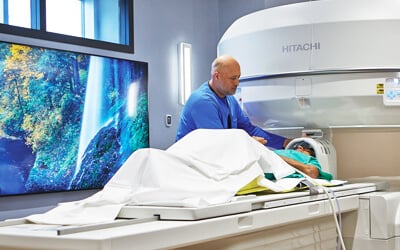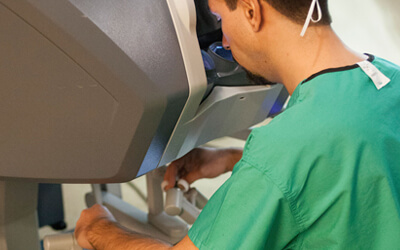Lung Cancer Treatments and Technologies
We are on the forefront of lung cancer treatment and technology advancements.
At OhioHealth, we offer comprehensive treatment options and develop a care plan that’s best for you and most effective in treating your type of lung cancer.

Comprehensive Lung Cancer Treatments and Technology
Advanced Imaging
Our advanced imaging technology determines the stage and genetic characteristics of your lung cancer. This enables our physicians to precisely locate and access a tumor, especially in difficult-to-reach areas. These may include:
- CAT scan (CT) guided biopsy
- Endobronchial ultrasound (EBUS)
- Electromagnetic navigation bronchoscopy (ENB OR SUPERDIMENSION™ NAVIGATION SYSTEM)
Surgery
Whether we use surgery depends on your cancer condition and overall health. The type of procedure we recommend will depend on the size and location of the tumor, as well as your overall health and condition. Surgical procedures we offer for lung cancer include:
- Lobectomy
- Wedge Resection Removal
- Segmentectomy
- Sleeve Resection or Sleeve Lobectomy
- Pneumonectomy

Minimally Invasive Treatment Options
Robotic or robot-assisted surgery and video-assisted thoracic surgery enable your surgeon to perform some surgeries with more precision, flexibility and control. Advantages of these minimally invasive procedures usually include less pain, a shorter hospital stay and quicker recovery.
Medical Oncology
Our chemotherapy, immunotherapy and targeted therapies are highly individualized. Your medical oncologist, in collaboration with your lung cancer care team, will work together to determine and monitor the most effective chemotherapy treatment for your cancer.
We also offer targeted therapies. These drug treatments block the growth and spread of cancer by interfering with specific molecules that are involved in the growth, progression and spread of cancer. This includes hormone therapy.
Genetic Sequencing
Testing cancer cells for mutations in genetic content can assist with selecting targeted drug therapy and understanding prognosis.

Radiation Therapy
Radiation therapy is unique to each individual and directed by the radiation oncologist. All of our radiation therapy locations have real-time access to your care plan so that you can schedule appointments at whatever time and location is most convenient. Depending on the type of cancer you have, we use these main types of radiation:
- Brachytherapy — placing radioactive material inside the body to treat cancer
- Intensity-modulated radiation therapy (IMRT) — delivering precise radiation doses to a tumor or specific areas within the tumor using advanced technology to move beams of radiation to conform to the 3D shape of a tumor
- Stereotactic radiotherapy — using focused, high-dose radiation beams to target a well-defined tumor from different angles
- 3D conformal radiation therapy (3D CRT) — using the results of imaging tests, such as MRI and special computers, to target the location of the tumor
Interventional Radiology
Interventional radiology targets and treats cancers that cannot be treated surgically by using heating, cooling or microwave energy to kill tumor cells. Patients benefit from low-risk complications and, in some cases, return home the same day.

Lymphedema Therapy
We provide manual therapy treatments and techniques to reduce lymphatic fluid accumulation (tissue swelling).
Cancer Rehabilitation
Our specialized therapists develop an exercise program to improve joint mobility, restore flexibility, reduce pain and improve strength so you can safely return to your usual activities.
OhioHealth Infusion
Chemotherapy and biotherapy for both cancerous and noncancerous conditions, including intravenous, intraperitoneal, intravesicular routes and intrathecal chemotherapy administration at some infusion locations.
- Transfusion therapy
- Intravenous antibiotics
- Intravenous hydration and electrolyte replacement
- Iron infusions
- Subcutaneous and intramuscular injections (such as Epogen® and Neulasta®)
- Intravenous gamma globulins
- Therapeutic phlebotomy
- Central venous catheter maintenance
- Peripheral and central venous catheter lab draws
- PICC line placement at some locations
- Individualized patient education
- Integrative therapies at some locations, such as massage, art therapy, acupuncture and nutrition counseling
- Oncology patient navigation
- Pharmacist consultation